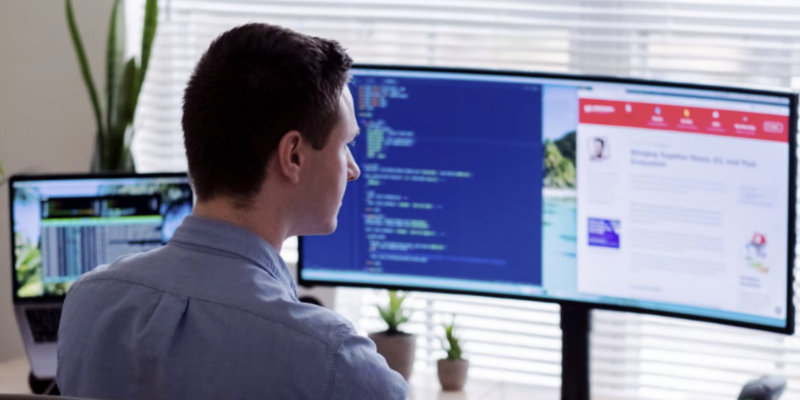Furniture as a model industry in the circular transition

The office furniture industry has made great circular strides in a relatively short space short time. Three major tenders are the basis for this. Alliander set the tone in 2013, followed by the University Medical Centre Utrecht (2016) and the national government (2017). Meanwhile, circular ambitions and performance have become an integral part of the industry. We spoke to three professionals in the field about how this came about and what challenges remain to be tackled.
What is circular furniture?
At ikwilcirculairinkopen.nl, circular furniture refers to producing, using and maintaining furniture based on circular principles.
For example:
- Repairing existing furniture or otherwise extending its service life
- Using reused furniture
- Producing new furniture with a long service and parts that can be disassembled, made from non-toxic materials
First major circular request from national government represents turning point
In 2017, the national government presented a circular vision for office furniture. That vision was followed by a series of contracts. The first contract was a big one – over 100,000 workstations were fitted with circular furniture.
‘That huge circular request from the government was a turning point in the office furniture industry,’ explains Hans Bloemendaal. He was once employed by Rohde and Grahl and is now active as a SRP consultant at PIANOo, the procurement expertise centre of the Ministry of Economic Affairs and Climate.
‘That call really shook the market. It became clear, all the way to the very top of selected suppliers, that design and production need to change. That sales departments need to start working with different revenue models. Extending the service lives of products is an increasingly important part of this.’
Why are circular ambitions needed?
The office furniture industry has an intrinsically linear nature – the focus is primarily on production.
Factories are set up for production and that is how turnover is generated. Furniture that no longer reflects the latest trends is replaced.
Just like furniture that only needs a little maintenance.
Much of that also ends up as waste too.
And the good news? The opportunities are there!
New parties are coming through
The opportunities available in the industry have not gone unnoticed and several new parties have entered the market in recent years. Not just parties that refurbish and re-upholster furniture, but parties that buy used furniture, keep it in stock and use it to bid for tenders as well.
One of those new parties is Workbrands, with its commercial manager Ramon van de Kerkhof: ‘We can see how the landscape is changing. There are an ever increasing number of circular initiatives. For us, it’s important that we’re able to take part in tenders. This requires change amongst clients. We need to move away from linear thinking and predetermined prices, and move more towards equal partnerships.’
No going back – 40 per cent of calls for tender are now circular
‘The industry is developing fast, there’s no going back,’ explains Tamara van Vastenhoven. Tamara works at the government department Rijkswaterstaat where she is a workplace environment category manager for the central government.
‘An ever increasing number of clients are setting circular ambitions when procuring furniture. One supplier estimates that around 40 per cent of office furniture tenders now have a circular focus. That represents a massive increase over a few years ago.’
More uniformity through NEN working group and practical guideline
‘Circular’ is thus increasingly becoming the standard. To make the most of it, unambiguity is essential. As an industry, what do we consider ‘circular’? And where do we put our focus? To answer these questions, Hans Bloemendaal and others started the NEN working group on circular furnishing of office and learning environments in 2019.
‘We noticed that clients were all asking for different aspects of circularity. That’s far from ideal, as it forces you to answer a different question every time. More uniformity makes it possible for market parties to invest. That stimulates further development.’
The NEN working group has decided to draft a Dutch practical guideline (NPR). There was already an NPR for the industry, covering dimensions and quality aspects, so the tool was quite familiar. ‘This NPR is a great example of the development in the market,’ explains Tamara. ‘Suppliers have arrived at a standardised language along with some of the industry’s clients and other parties. I have seen how participants have looked beyond their organisational interests to move the industry forward together.’
Challenges for the years ahead
There remain plenty of challenges in the industry. One is the fact that sustainability is still very much person-specific and organisation-specific. Tamara continues, ‘Circularity is a way of life. It should be in your organisation’s DNA. But, in conversations about contract management, you still notice a clear difference between parties who have reuse as a point of departure, and those who start by focusing on new furniture.’
Hans agrees that the revenue model of many suppliers is still based on production. ‘After all, there remains considerable demand for new furniture, with few circular requirements. To change this, it’s important that clients continue to put out circular calls for tender in a structural fashion.’
‘The uncomfortable truth is that we are still to see a transformation across the industry,’ explains Ramon. ‘There is still a distinction between circular stories and actual circular solutions.’
In addition, Ramon has also noticed that circular furniture often tends to be more expensive, as labour is expensive in the Netherlands. ‘There’s also ignorance to contend with, on the possibilities that reused furniture offers, for example. Plus there are myths about what consumers consider important, such as in terms of looks and functionality. But, we have the ability to change that.’
For Tamara, starting to think from the perspective of supply is important. Clients, including the government, still think in terms of demand. ‘We are trying to change that,’ Tamara explains. ‘Only by thinking in terms of supply can we use as much as possible of what’s already available.’
An example for other industries
Despite continuing demand for ‘traditional’ new furniture, the industry has, in recent years, made it clear that circularity is possible. Due to a number of large-scale tenders with high ambition, major market parties cannot be left behind.
We’re hearing that the position of sustainability managers within their organisations has been bolstered. This is an important step in changing organisations from the inside.
TAMARA VAN VASTHOEVEN – CATEGORY MANAGER FOR DESIGN AT RIJKSWATERSTAAT
Circular ambitions? Furniture is a logical first step
If you have circular ambitions, then office furniture is a logical first step. Furniture, such as desks and chairs, is perfect for refurbishment. These pieces of furniture are also relatively easy to adapt to changing needs. And as every office worker uses furniture, you can disseminate the circular story throughout the organisation with ease. Get this part right, and your employees will connect with their employer’s circular ambitions. It also paves the way for more steps in the circular direction!


